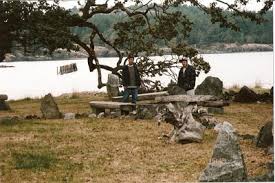…and how modern society fails to meet them.
Hi everyone. I hope your summer is going smoothly, safe from insects, droughts, forest fires, and other human-assisted calamities. I’m on vacation in France now, after a harrowing trip giving talks, first in Victoria, Canada, and then in Melbourne and Brisbane. Harrowing because I flew across 16 time zones, then back, in just a week. But it was a great trip, the highlight of which was hanging out with inmates, then giving a talk, at a beautiful prison on Vancouver Island. I know the phrase “beautiful prison” is rare, but this was a rare place. It included an area for First  Nations rituals (complete with sweat lodge!), a Buddhist meditation parkette, and wild deer running everywhere. The only problem for the prisoners was that they couldn’t leave. The place was a living contradiction, and of course most inmates had been through addiction. A few of them gave me lovely gifts when I left. They spent their time developing craftsmanship in wood and metal. (And yes, I was allowed to leave — but I felt a familiar anxiety at the exit post, left over from years ago.)
Nations rituals (complete with sweat lodge!), a Buddhist meditation parkette, and wild deer running everywhere. The only problem for the prisoners was that they couldn’t leave. The place was a living contradiction, and of course most inmates had been through addiction. A few of them gave me lovely gifts when I left. They spent their time developing craftsmanship in wood and metal. (And yes, I was allowed to leave — but I felt a familiar anxiety at the exit post, left over from years ago.)
Now that the zillions of comments on April’s moving post have finally died down, here’s a “vacation post” — a shortened and revised version of an article I published in The Guardian about a month ago. I’ve been asked many times what I think about the opioid/overdose epidemic hitting the US and Canada in particular but also the UK and other regions. Here are my thoughts.
……….
Most drug-related deaths result from the use of opioids, the molecules that are marketed as painkillers by pharmaceutical companies and heroin by drug lords. Opioids comprise a large family of molecular cousins, some weak, some powerful, all united by their capacity to bond with the opioid receptors all over our bodies, particularly our brains. Those receptors evolved to protect us from panic, anxiety, and pain. But the gentle impact of natural opioids, produced by our own bodies, resembles a summer breeze compared to the hurricane of physiological disruption caused by drugs — opiates — designed to mimic their function. And as if heroin wasn’t enough of a bull in the China shop, most street opiates (including heroin) are now laced or replaced with  fentanyl and its analogues, far more powerful than heroin and so cheap that drug-dealing profits are skyrocketing at about the same rate as overdose deaths. People don’t know what they’re getting and they take too much. Fentanyl is recognized as a primary driver of the overdose epidemic.
fentanyl and its analogues, far more powerful than heroin and so cheap that drug-dealing profits are skyrocketing at about the same rate as overdose deaths. People don’t know what they’re getting and they take too much. Fentanyl is recognized as a primary driver of the overdose epidemic.
Society’s response has been understandably desperate but generally wrong-headed. We start by blaming addicts for their self-indulgence or weakness of will. We blame the pharmaceutical companies for  developing and marketing painkillers. We blame doctors, for overprescribing opiates, which pressures them to underprescribe them, which drives patients to street drugs — cheaper, home-delivery via the
developing and marketing painkillers. We blame doctors, for overprescribing opiates, which pressures them to underprescribe them, which drives patients to street drugs — cheaper, home-delivery via the  internet, and zero quality control. We say we’re going to rekindle the war on drugs, recognized by experts as a colossal failure from the thirties onward. Dealers will always find their way to consumers if the price is right. We also continue to view addiction as a chronic brain disease, so the benefits of education, social support, and psychological intervention receive far too little attention. Black-and-white solutions are simply inadequate for a problem of such complexity.
internet, and zero quality control. We say we’re going to rekindle the war on drugs, recognized by experts as a colossal failure from the thirties onward. Dealers will always find their way to consumers if the price is right. We also continue to view addiction as a chronic brain disease, so the benefits of education, social support, and psychological intervention receive far too little attention. Black-and-white solutions are simply inadequate for a problem of such complexity.
There has been some progress: There are pockets of activity here and there where prescribed opiates — like methadone and buprenorphine (Suboxone) — are made more easily available to addicts. That’s a good thing, because increasing addicts’ desperation (e.g., methadone clinic line-ups on the far side of town) often drives  them to the street, where they’re most likely to die. The availability of naloxone, an opiate neutralizer, is slowly wending its way through the drug policy jungle, providing a simple resource to combat overdose on the spot. But in most segments of most communities in the US and elsewhere, naloxone is still too difficult to obtain.
them to the street, where they’re most likely to die. The availability of naloxone, an opiate neutralizer, is slowly wending its way through the drug policy jungle, providing a simple resource to combat overdose on the spot. But in most segments of most communities in the US and elsewhere, naloxone is still too difficult to obtain.
I think there are smarter answers at hand — but also smarter questions to be asked. The opioid overdose epidemic compels us to face one of the darkest corners of modern human experience head on, to stop wasting time blaming the players and start looking directly at the source of the problem. What does it feel like to be a human trying to make it in the early 21st century? Why are we so stressed out that our own (internal) supply of opioids isn’t enough to feel okay?
The overdose crisis obviously builds on people’s desire for opioids. But what do opioids actually do? The opioid system was designed by evolution to allow us to function, not panic or shut down, when we are under threat or in pain. Critically, support from other humans also helps us cope with stress, and that support is underpinned by  opioids too. Our attachment to others, whether in friendship, family, or romance, requires opioid metabolism so that we can feel the love. Opioids grant us a sense of warmth and safety when we connect with each other. You get opioids (from your own brain stem) when you get a hug. Breast milk is rich with opioids. Rodents play more when given mild doses of opioids.
opioids too. Our attachment to others, whether in friendship, family, or romance, requires opioid metabolism so that we can feel the love. Opioids grant us a sense of warmth and safety when we connect with each other. You get opioids (from your own brain stem) when you get a hug. Breast milk is rich with opioids. Rodents play more when given mild doses of opioids.
 In short, we need opioids to feel safe and to connect with each other. Then what does it say about our life-style if our natural supply isn’t sufficient? It says we are stressed and isolated. That’s a problem we need to resolve.
In short, we need opioids to feel safe and to connect with each other. Then what does it say about our life-style if our natural supply isn’t sufficient? It says we are stressed and isolated. That’s a problem we need to resolve.
To confront the problem of addiction, many have proposed targeted education, community support, and interpersonal bonding through group activities. Johann Hari’s powerful book, Chasing the Scream, reviews how such initiatives have worked in diverse societies. An intriguing example is the compassionate, blame-free dialogue that has naturally evolved among high-school students in Portugal, highlighting the dangers of hard drugs and urging the most vulnerable to abstain — not because they’re going to get in trouble but because addiction is miserable and dangerous! The emergence of this dialogue has been particularly meaningful because it has paralleled the decriminalization of drug use. Portugal had an astoundingly high heroin addiction rate 17 years ago. It now boasts the second lowest overdose rate on the continent. Drug addiction has diminished significantly in Portugal because compassion and social inclusion actually work against addiction, while punishment only fuels it.
But let’s look beyond the challenge of addiction per se. The peculiar appeal of opioids tells us more about ourselves as a society, as a culture, than addiction statistics can reveal. Today’s young people come of age and carve out their adult lives in an environment of astronomical uncertainty. Corporations that used to pride themselves on fairness to their employees now strive only for profit. The echelons of management are as risk-infected as those of the lowest clerks. Massive layoffs rationalized by the eddies of globalization make long-term  contracts antique. I ask the guys who come to the house to deliver packages or upgrade our TV box how they like their jobs. They can’t say. They get up to three six-month contracts in a row and then they get laid off so the company won’t have to pay them benefits. People pour out of colleges and universities with all manner of degrees, yet with skills that are rapidly becoming irrelevant. But people without those degrees are
contracts antique. I ask the guys who come to the house to deliver packages or upgrade our TV box how they like their jobs. They can’t say. They get up to three six-month contracts in a row and then they get laid off so the company won’t have to pay them benefits. People pour out of colleges and universities with all manner of degrees, yet with skills that are rapidly becoming irrelevant. But people without those degrees are  even worse off. They find themselves virtually unemployable, because there are so many others in the same pool, and employers will hire whoever comes cheapest. (The absurdly low minimum wage figures in the US clearly exacerbate the situation.) As hope for steady employment fizzles, so does the opportunity to connect with family, friends, and society more broadly, and there is way too much time to kill. Opioids help reduce the despair.
even worse off. They find themselves virtually unemployable, because there are so many others in the same pool, and employers will hire whoever comes cheapest. (The absurdly low minimum wage figures in the US clearly exacerbate the situation.) As hope for steady employment fizzles, so does the opportunity to connect with family, friends, and society more broadly, and there is way too much time to kill. Opioids help reduce the despair.
The opportunity to settle into a viable niche in one’s family and one’s society, the bedrock of social and personal security, is being blown away by the winds of unregulated capitalism in a globalized world. As for the intimacy and trust we humans have always sought in each other, in friends, colleagues, and lovers, the bonds are shaky these days. Even if we have the opportunity to connect — if we are not resettling geographically to find employment or staying up late to retool through distance education or simply sitting on the sofa all day long collecting welfare — we’re still too stressed and depressed to get to know each other, to develop trust, to give and receive compassion.
(The links between under-employment, family dissolution, and addiction are beautifully reviewed by Sally Satel. And many of you may know of Bruce Alexander’s explanation of how globalization feeds addiction.)
The early 21st century offers less structure and stability through religion, and through extended family relationships, than we have experienced in thousands of years. And maybe that’s just the way it is. But we don’t have to throw away the basic currency of security and interconnectedness entirely. We can build social structures — governments, corporations, community organizations, and systems of education and care — that encourage stability, hope, and trust in our day-to-day lives. Like the high-school kids in Portugal, we can offer compassion and inclusion as an alternative to heroin. If we fail to do that, many of us will want to hook ourselves up to an opioid pump. Just to endure.
……..
I’m not entirely pessimistic, but that’s the way I see it. Regardless, let’s not give up hope, not even slightly. Let’s do a bit of meditation, enjoy the sunshine, and be good to each other. See you again in September.

Leave a Reply